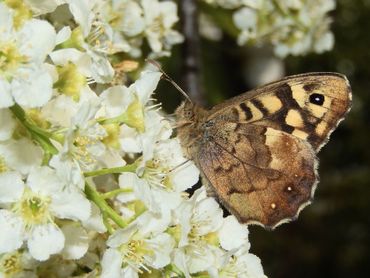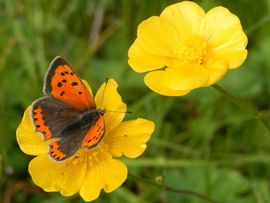
Home / EU Policy / EU CAP Reform
Organisations representing 2500+ scientists called on the European Parliament for a total reform of the CAP. Intensive agriculture is destroying nature: the EU has a duty to avert this crisis.
Intensification of agricultural practices, including landscape simplification and consolidation, increases in the use of pesticides and mowing frequency, irrigation expansion and the destruction of pasture lands have led to a decline of European farmland bird populations of more than 61% between 1980 and 2015, and a decline of insect population abundance of more than 76 % in a study of 63 nature reserves in Germany between 1989 and 2016.
You can read the Open Letter Reform the CAP, signed by Butterfly Conservation Europe, European Ornithologists Union, European Mammal Foundation, Societas Europaea Herpetologica.

Pararge aegeria - Speckled wood
The Eu Farm to Fork Strategy (F2F) was published on 5 October 2020 and committed to integration of EU Green Deal goals, including supporting biodiversity in farmed areas; reducing pressures
from nitrogen and phosphorus; reducing pesticide use; and supporting climate goals; alongside improving farmers’ incomes and delivering safer food more sustainably.
A link to the F2F Strategy is here, available in all EU languages, Extracts from the EU Commission F2F Action Plan, which are most relevant to the environment and biodiversity recovery are here:
EU Farm to Fork Strategy Extracts (0.11 MB  )
)

On 2 December 2021, the agreement on the reform of the EU Common Agricultural Policy (CAP) was formally adopted. The new legislation, which came into force in 2023, paved the way for a fairer, greener and more performance-based CAP. Agriculture and rural areas are central to the European Green Deal, and the current CAP is positioned as a key tool in reaching the ambitions of the Farm to Fork and Biodiversity strategies.
Although these strategies profess a high ambition for the contribution of CAP to recovery of biodiversity and ecosystem health it has become clear from the implementation of the CAP through Member State Strategic Plans that many national plans lack the ambition or investment needed to meet biodiversity targets. The European Commission has highlighted shortcomings in environmental and climate measures, and civil society groups continue to raise concerns about weak commitments to habitat restoration, pesticide reduction, and support for extensive or nature-friendly farming.
The EU CAP has a budget of €386.6bn - one third of the whole EU budget.
Link to EU Commission information on reformed CAP 2023: https://ec.europa.eu/info/food-farming-fisheries/key-policies/common-agricultural-policy/new-cap-2023-27_en
The 10 Objectives of the reformed CAP are:
To see Briefs on these objectives https://ec.europa.eu/info/food-farming-fisheries/key-policies/common-agricultural-policy/new-cap-2023-27/key-policy-objectives-new-cap_en#documents
Many butterflies are highly dependent on sustainable agricultural management to sustain their populations. Many grassland butterflies, including those of European importance, listed under the EU Habitats Directive are in Unfavourable Conservation - inadequate or - bad status.
Extensive agriculture favores the biodiversity with intermediate disturbance and control pressures
The EU Grassland butterfly Indicator shows a 25% decline in abundance since 1990. Protection of their remaining habitats and reductions in pressures, eg from nitrogen enrichment, toxic pesticides, fertilisation or ploughing are urgently needed. Together with investment to increase suitable habitat; to halt grassland abandonment; and to sustain extensive mowing or grazing of semi-natural grasslands. Many insect pollinators depend on these habitats too and their populations are at risk, threatening a loss of vital pollination services to crops, fruit and vegetables and wildflowers. Both diversity and abundance of insects are important for resilience. Semi-natural grasslands also provide climate services through sequestering carbon.
Each EU country has developed a national CAP strategic plan, combining funding for income support, rural development, and market measures. In designing these plans, Member States contribute to the ten specific CAP objectives using a common set of policy tools provided by the European Commission, adapted to national priorities and conditions. CAP specific objectives by country.
All EU countries submitted their Strategic Plans by 31 December 2021, and the European Commission completed its approval process by the end of 2022. Implementation of the new CAP began in January 2023 and is now underway across all Member States. The Commission is currently monitoring performance through annual reporting and mid-term evaluations based on the criteria set out in CAP strategic plan regulation.

In Spring 2022, leading environmental NGOs expressed significant concerns about the failure of these draft plans to include sufficient action for biodiversity and ecosystem recovery. By the end of May 2022, the Commission had sent observation letters relating to all 28 draft CAP strategic plans that were submitted by EU countries. The letters identify elements of the proposed plans that require further explanation, completion or adjustments before the Commission can approve them. Each EU country responded to their observation letter, and the Commission worked with national authorities throughout the remainder of 2022 to revise the plans. While the Commission ultimately approved all national Strategic Plans by December 2022, concerns persist that many of the approved plans still fall short of what is needed to halt biodiversity decline in agricultural landscapes.
Alongside the letters themselves, the Commission has created an overview of the content of the letters, which summarises the key elements of the 28 proposed plans and the related observations which were made for each country.
For fact sheets about the farming sector (up to 2020) in each Member State with information about Conservation status of protected grasslands; forest and agriculture area under Natura 2000; and protection of natural resources see https://ec.europa.eu/info/food-farming-fisheries/farming/facts-and-figures/performance-agricultural-policy/agriculture-country/cap-specific-objectives-country_en
CAP legislation lays down a common set of indicators as part of a new performance, monitoring and evaluation framework. The indicators are now being monitored through annual performance reports, first submitted in 2024, and a mid-term performance review of the CAP Strategic Plans, scheduled for 2025, to assess the progress of EU countries in reaching their targets and the objectives of the CAP.